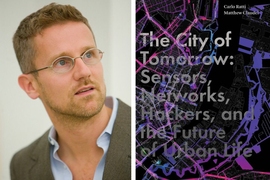MIT scholar Carlo Ratti has been named curator of the Venice Biennale’s 19th International Architecture Exhibition, to be held in 2025.
The large-scale exhibition is the world’s best-known showcase for architectural work. It began in 1980 and has normally been held every two years since then.
Ratti is an expert in urban design and planning, who has conducted many innovative studies of city dynamics using mobile sensors and other technologies, revealing insights that can be applied to the built environment on many scales. At the same time, Ratti is an active designer whose work has been displayed previously at the Venice Biennale, along with New York City’s Museum of Modern Art, the Design Museum in Barcelona, and the Museum of Science in London, among other venues.
Currently, Ratti is professor of the practice of urban technologies and planning within MIT’s Department of Urban Studies and Planning.
“We architects like to think we are smart, but real intelligence is everywhere,” Ratti said in a statement released by the Biennale. “The disembodied ingenuity of evolution, the growing power of computers, and the collective wisdom of the crowd. To face a burning world, architecture must harness all the intelligence around us. I am honored and humbled to have the opportunity to curate the Biennale Architettura 2025.”
AT MIT, Ratti also serves as director of the Senseable City Lab, which he founded. In addition to his studies and design projects, Ratti has authored multiple books, including “The Atlas of the Senseable City” (2023), co-authored with Antoine Picon of Harvard University, and “The City of Tomorrow: Sensors, Networks, Hackers, and the Future of Urban Life” (2016), co-authored with Matthew Claudel.
Ratti is a founding partner of the architecture and innovation office CRA-Carlo Ratti Associati, which has office in Turin, New York City, and London. He graduated from the Politecnico di Torino, and the École Nationale des Ponts et Chaussées in Paris. He conducted his MPhil and PhD work at the University of Cambridge, and completed his PhD thesis as a Fulbright Scholar at MIT.
Ratti is the second person from MIT selected as curator of the architecture Biennale in recent years. Hashim Sarkis, dean of MIT’s School of Architecture and Planning, served as curator for the Biennale in 2021 — which was originally scheduled to run in 2020, but got delayed for one year due to the Covid-19 pandemic.
MIT artists have also been well represented at the Venice Biennale’s International Art Exhibition, which also runs every two years. The MIT List Visual Arts Center has presented three exhibitions at the Biennale, featuring Joan Jonas, Fred Wilson, and Ann Hamilton.
The 19th International Architecture Exhibition will run from May 24 through Nov. 23, 2025.











